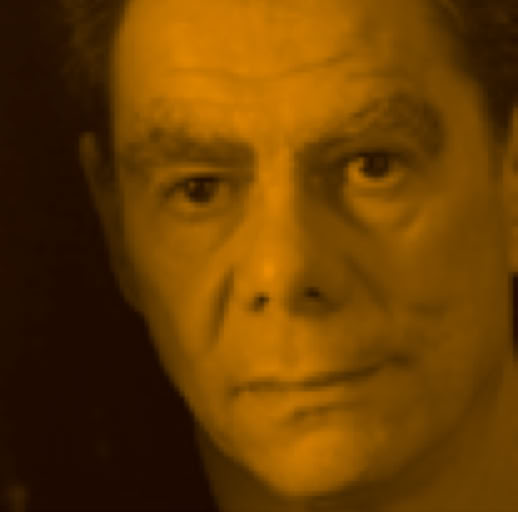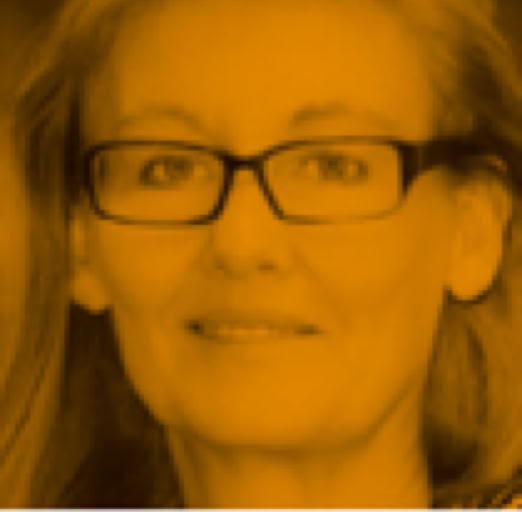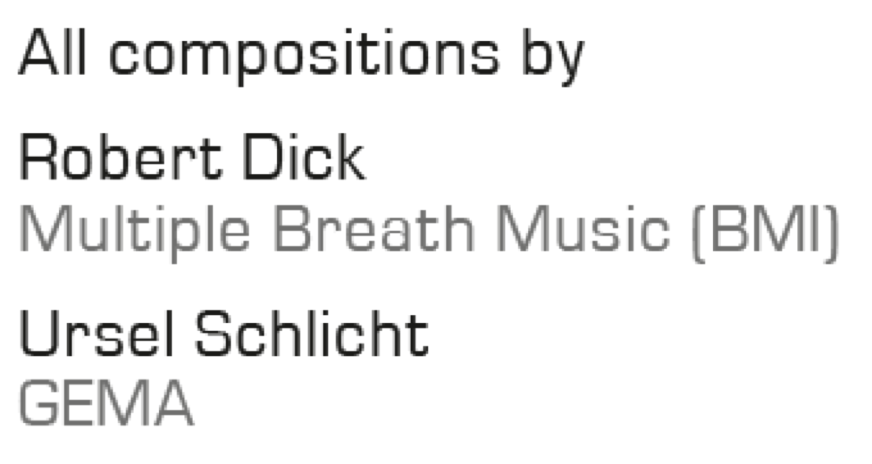CATALOG nemu 017

Recorded and mixed by Matt Mehlan
at Roulette, NYC, 2009-13.
Mastering by M.S.M.-Engineering.
Photos by Ele Nielsen, Fotolia, Fred
George, Karsten Socher.
Graphic design by Christiane Resch.
Notes by Allan Kozinn.
Produced by Robert Dick & Ursel
Schlicht.
contact / booking:
Robert Dick - flutes
Ursel Schlicht - piano


It is probably no coincidence that space imagery so frequently figures into this duo‘s album titles. The present recording, “The Galilean Moons,” is the successor to the 2005 collaboration “Photosphere,” and if you delve deeper into the catalogue, you will find Robert Dick’s “Jazz Standards On Mars,” Ursel Schlicht’s “String Theory” and “Einstein’s Dreams”, Robert’s “Third Stone from the Sun” and “Worlds of If,” the last two taken from a Jimi Hendrix song and a classic 1960‘s science fiction magazine.
“Good science fiction is not about rockets and robots, but about people in very different circumstances from what we know,“ Robert said, “so for me it’s been kind of a theme.” For a listener there is a musical connection, too: both Dick and Schlicht have devoted themselves to stretching the sonorities and textures listeners expect from their instruments, and to sculpting fresh musical forms in which elements of formal composition and improvisation are blended. Theirs is music that looks forward and pushes toward a future in which limitations are swept away (Who says you can’t bend pitches or play glissandos on the flute and piano? Watch us!), but in which the art’s purely human aspect – the exchanges and interplay that make music a conversation that goes beyond words – remain in the spotlight.
The Galilean Moons, the four-movement suite from which this collection takes its title, was co-written for the Festival Cervantino in Guanajuato, Mexico, in 2009, a celebration of Galileo. The four moons of Jupiter – Io, Europa, Callisto and Ganymede – inspired fascinating sonic landscapes. “Io has more volcanoes than any other moon in the solar system, Europa has an icy surface with, perhaps, life underneath. It gave us some very, very nice imagery”, related Ursel.
In the performance captured here, their aural imagery varies across the expanse of the set, from flute multiphonics and percussive sounds in their portrait of the volcanic Io, to a metallic piccolo sound and mysterious, glittering high timbres in their evocation of the icy Europa. Callisto is depicted in sudden, burst-like piano chords that melt into resonance, along with pitchbending, chordal alto flute tones. And an alternation of airy, fluttering flute sounds, vocalizations and brusque, solid keyboard chords capture the grandeur of Ganymede, the solar system’s largest moon.
The album opens with Tendrils, a work by Schlicht inspired by the possibilities that Dick’s invention, the Glissando Headjoint® offers. The results here are kaleidoscopic, with wild flute figures opening the work, and Schlicht supplying tactile figures on the keyboard’s upper reaches, and harp-like textures from inside the piano. A Lingering Scent of Eden was inspired by a reading of Alan Wiseman’s “The World Without Us,” particularly a chapter about the Bialowieza Puszcza between Poland and Belarus, undisturbed landscapes, areas that have not been manipulated by humans. Schlicht took her title from that chapter. “Images of open space, birds, wind and weather”, she says. There is also, interestingly, an approach to harmony that moves further toward jazz than anything else here.
Sic Bisquitus Disintegrat has a written-out head, played in unison with open fifths, upon which Dick and Schlicht extemporize. It’s Latin title means, loosely
translated, “That’s the Way the Cookie Crumbles.”
Dark Matter is a historic work, of sorts: it is almost certainly the first chamber work to make creative use of the nonsense texts that internet spammers affix to emails in the hope of eluding spam filters. “I wouldn’t pay any attention to the spam, but I started
to collect those blocks of random text,” Dick says. “Sometimes they say really amazing things.” Throughout the piece, Dick recites these texts, drawing fascinatingly
matched musical responses from Schlicht at the piano, and adding commentary of his own on the rarely heard contrabass flute.
The concluding work, Dick’s richly episodic Life Concert, dates to 1997. It explores the angularity of European atonalism, a touch of bluesiness here and there, and the sounds of far-flung cultures. Certain passages for the piano, in which the strings are muted, were inspired by the sound of the kalimba, an African thumb piano. And the themes of the final movement were derived from an Indian raga, Raga Multani – but with a twist. “It’s hardly an explication of the raga in a classic Hindustani way,” Dick explains. “I move the tonal center around, which is something that Indian musicians would never do. Why not make the scales analagous to the way chords are used and have one mode move to another, and one key center to another?“ – Why not, indeed.
Allan Kozinn, New York, 2015